1998 GMC SAVANA fuel pressure
[x] Cancel search: fuel pressurePage 7 of 388
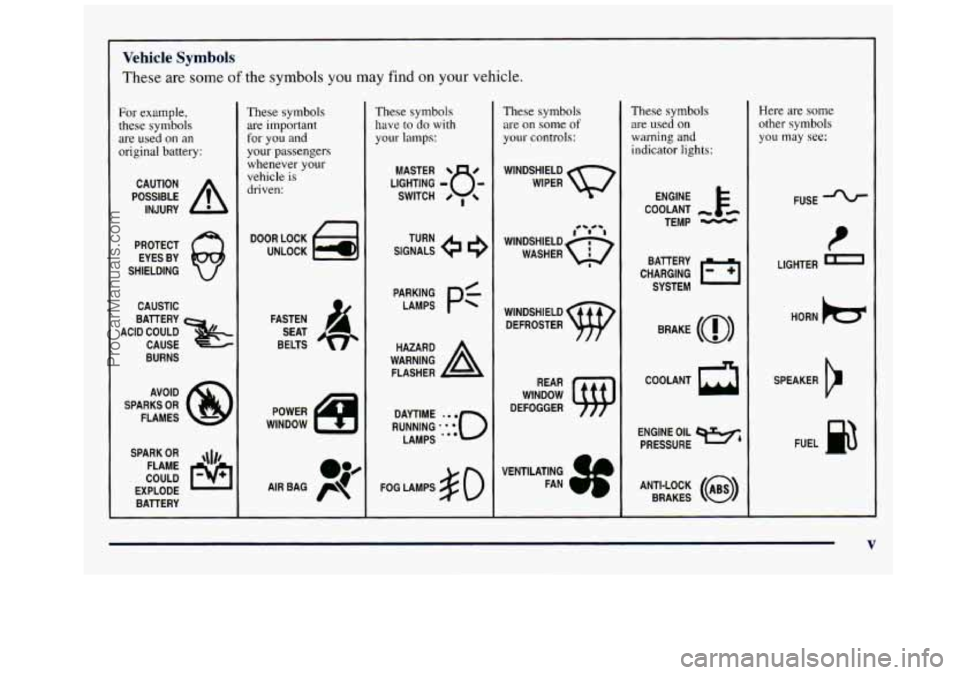
Vehicle Symbols
These are some of the symbols you may find on your vehicle.
For example,
these symbols
are used on
an
original battery:
POSSIBLE A
CAUTION
INJURY
PROTECT EYES BY
SHIELDING
CAUSTIC
BAlTERY
CAUSE
BURNS
ACID COULD
&
AVOID
SPARKS
OR
FLAMES
SPARK
OR ,\I/,
COULD FLAME
EXPLODE BATTERY
These symbols are important
for you and
your passengers whenever your
vehicle is
driven:
DOOR LOCK
UNLOCK
FASTEN SEAT
BELTS
These symbols have
to do with
your lamps:
SIGNALS e e
TURN
FOG LAMPS
$0
These symbols
are on some
of
your controls:
WINDSHIELD
WIPER
WINDSHIELD DEFROSTER
WINDOW
DEFOGGER
VENTILATING FAN
These symbols are used
on
warning and
indicator
lights:
COOLANT -
TEMP -
CHARGING l=l
BATTERY
SYSTEM
BRAKE
(0)
COOLANT a
ENGINE OIL e,
PRESSURE
ANTI-LOCK
(@)
BRAKES
Here are some
other symbols
you may
see:
FUSE -%-
P
LIGHTER m
HORN )cr
SPEAKER
b
FUEL p3
V
ProCarManuals.com
Page 132 of 388

Have you recently changed brands of fuel?
If
so, be sure to fuel your vehicle with quality fuel (see
“Fuel” in the Index). Poor fuel quality will cause your
engine not to run as efficiently as designed. You may
notice this
as stalling after start-up, stalling when you
put the vehicle into gear, misfiring, hesitation on
acceleration or stumbling on acceleration. (These
conditions
may go away once the engine is warmed up.)
This will be detected by the system and cause the light
to turn on.
If you experience one or more of these conditions,
change the fuel brand
you use. It will require at least one
full tank of
the proper fuel to turn the light off.
If none of the above steps have made the light turn off,
have your dealer or qualified service center check
the
vehicle. Your dealer has the proper test equipment and
diagnostic tools to
fix any mechanical or electrical
problems
that may have developed.
Oil Pressure Gage
The oil pressure gage
shows the engine oil
pressure in psi (pounds per
square inch) when
the
engine is running. Canadian
vehicles indicate pressure
in kPa (kilopascals).
OIL -1
Oil pressure may vary with engine speed, outside
temperature
and oil viscosity, but readings above the
low pressure zone indicate the normal operating range.
A reading in the low pressure zone may be caused by a
dangerously low oil level or other problem causing low
oil pressure. Check your oil as soon as possible.
2-60
ProCarManuals.com
Page 184 of 388

The exit speed is usually posted.
Reduce your speed according to your speedometer,
not
to your sense of motion. After driving for any distance
at higher speeds, you
may tend to think you are going
slower than you actually are.
Before Leaving on a Long Trip
Make sure you’re ready. Try to be well rested. If you
must start when you’re not fresh
-- such as after a day’s
work
-- don’t plan to make too many miles that first part
of the journey. Wear comfortable clothing and shoes you
can easily drive
in.
Is your vehicle ready for a long trip? If you keep it
serviced and maintained, it’s ready to go. If it needs
service, have
it done before starting out. Of course,
you’ll find experienced and able service experts
in GM
dealerships all across North America. They’ll be ready
and willing to help if you need
it.
Here are some things you can check before a trip:
0
0
0
0
0
0
a
Windshield Washer Fluid: Is the reservoir full? Are
all windows clean inside and outside?
Wiper Blades: Are they in good shape?
Fuel, Engine Oil, Other Fluids: Have you checked
all levels?
Lamps: Are they all working? Are the lenses clean?
Tires: They are vitally important to a safe,
trouble-free trip.
Is the tread good enough for
long-distance driving? Are the tires all inflated
to the
recommended pressure?
Weather Forecasts: What’s the weather outlook
along your route?
Should you delay your trip a short
time to avoid a major storm system?
Maps: Do you have up-to-date maps?
4-20
ProCarManuals.com
Page 191 of 388
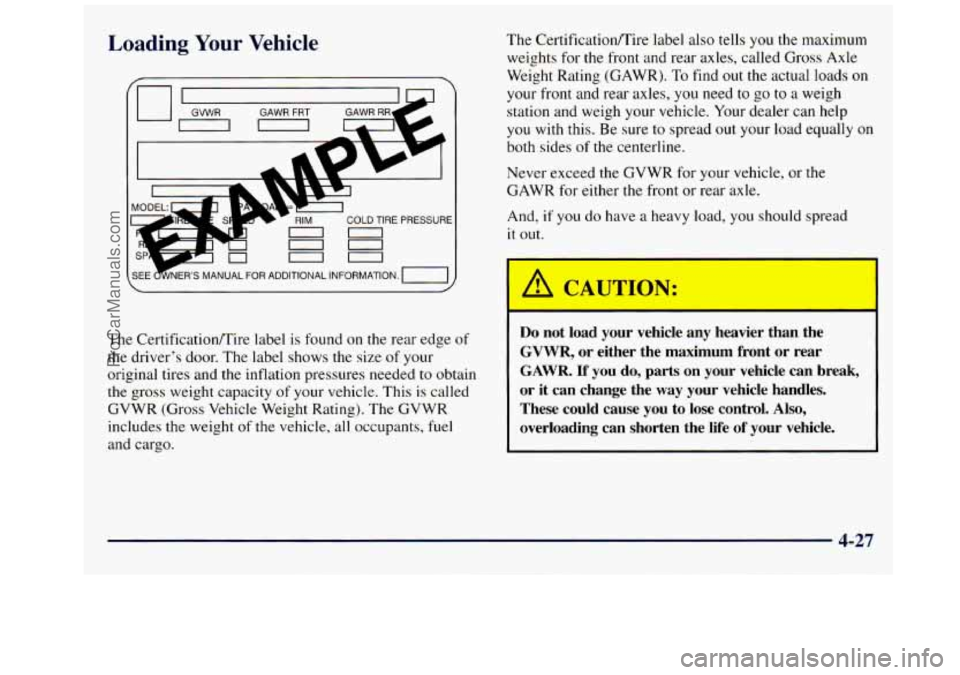
Loading Your Vehicle
COLD TIRE PRESSURE
00
00
00
The Certificationmire label is found on the rear edge of
the driver’s door. The label shows the size of your
original tires and the inflation pressures needed to obtain
the gross weight capacity
of your vehicle. This is called
GVWR (Gross Vehicle Weight Rating). The GVWR
includes the weight
of the vehicle, all occupants, fuel
and cargo. The
Certificationrnire label also tells
you the maximum
weights for the front and rear axles, called Gross Axle
Weight Rating (GAWR). To find
out the actual loads on
your front and rear axles, you need to go to a weigh
station and weigh your vehicle. Your dealer can help
you with this. Be sure to spread out your load equally on
both sides of the centerline.
Never exceed the GVWR for your vehicle, or the
GAWR for either the front or rear axle.
And,
if you do have a heavy load, you should spread
it out.
I
1
Do not load your vehicle any heavier than the
GVWR, or either the maximum front or rear
GAWR. If
you do, parts on your vehicle can break,
or it can change the way your vehicle handles.
These could cause you
to lose control. Also,
overloading can shorten the life of your vehicle.
4-27
ProCarManuals.com
Page 241 of 388
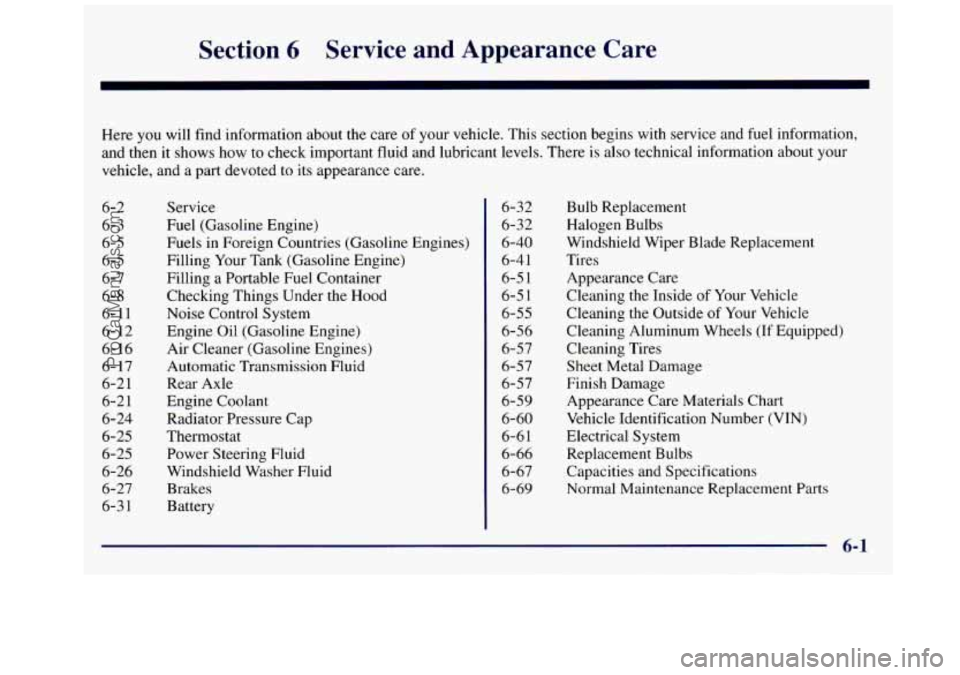
Section 6 Service and Appearance Care
Here you will find information about the care of your vehicle. This section begins with service and fuel information,
and then it shows how to check important fluid and lubricant levels. There is also technical information about your
6-2
6-3
6-5
6-5
6-7
6-8
6- 11
6- 12
6- 16
6-
17
6-2 1
6-2 1
6-24
6-25
6-25
6-26
6-27
6-3
1
vehicle, and a part devoted to its appearance care.
Service
Fuel (Gasoline Engine)
Fuels in Foreign Countries (Gasoline Engines)
Filling Your Tank (Gasoline Engine)
Filling a Portable Fuel Container
Checking Things Under the Hood
Noise Control System Engine Oil (Gasoline Engine)
Air Cleaner (Gasoline Engines)
Automatic Transmission Fluid
Rear Axle
Engine Coolant
Radiator Pressure Cap
Thermostat
Power Steering Fluid
Windshield Washer Fluid
Brakes
Battery
6-32
6-32
6-40
6-4
1
6-5 1
6-5 1
6-55
6-56
6-57
6-57
6-57
6-59
6-60
6-6
1
6-66
6-67
6-69 Bulb
Replacement
Halogen Bulbs
Windshield Wiper Blade Replacement
Tires Appearance Care
Cleaning the Inside
of Your Vehicle
Cleaning the Outside of Your Vehicle
Cleaning Aluminum Wheels (If Equipped)
Cleaning Tires
Sheet Metal Damage
Finish Damage
Appearance Care Materials Chart
Vehicle Identification Number (VJN)
Electrical System
Replacement Bulbs
Capacities and Specifications
Normal Maintenance Replacement Parts
6-1
ProCarManuals.com
Page 282 of 388
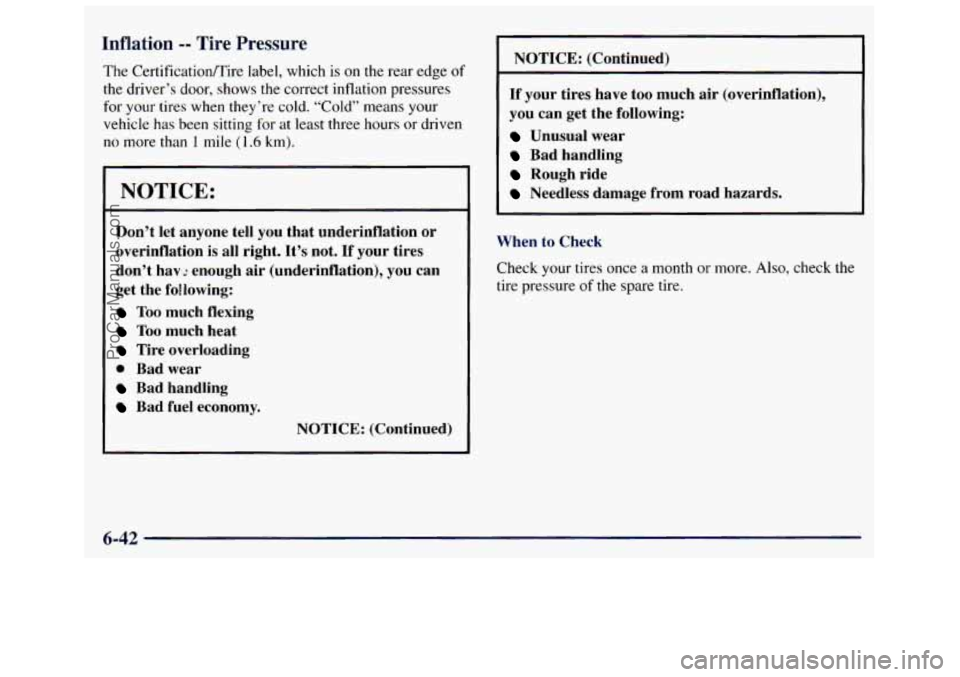
Inflation -- Tire Pressure
The Certificationflire label, which is on the rear edge of
the driver’s door, shows the correct inflation pressures
for your tires when they’re cold.
“Cold” means your
vehicle has been sitting for at least three hours or driven
no more than
1 mile (1.6 km).
NOTICE:
Don’t let anyone tell you that underinflation or
overinflation is all right. It’s not. If your tires
don’t
hav.2 enough air (underinflation), you can
get the following:
Too much flexing
Too much heat
Tire overloading
0 Bad wear
Bad handling
Bad fuel economy.
NOTICE: (Continued)
NOTICE: (Continued)
If your tires have too much air (overinflation),
you can get the following:
Unusual wear
Bad handling
Rough ride
Needless damage from road hazards.
Check your tires once
a month or more. Also, check the
tire pressure
of the spare tire.
6-42
ProCarManuals.com
Page 306 of 388

NAME
RH-HIBM
ECM-I
HORN
LH-HDLP
LH-HIBM
FUEL SOL
IGN-E
ECM-B
CIRCUITS PROTECTED
Right-hand High-beam Headlamp
(Export only)
Ignition Coil, Camshaft Position
Sensor,
VCM, Fuel Injectors, Coil
Driver
Horn Relay, Underhood Lamp( s)
Left-hand Headlamp (Export
only)
Left-hand High-beam Headlamp
(Export only)
PCM,
Fuel Solenoid Driver, Engine
Shutoff Solenoid
Air Conditioning Clutch Relay
Fuel Pump Relay, VCM, PCM, Fuel
Pump and Engine Oil Pressure
Switch
Replacement Bulbs
LAMP OR BULB
Sealed Beam Headlamps
Composite Low-Beam
Headlamps
Composite High-Beam
Headlamps
Front Sidemarker Lamp
Front Parking and Turn Lamp
Rear Parking Lamp
Rear Stop and Turn Lamp
Back- up Lamp
Back-up Lamp
Rear Parking, Stop, and
Turn Lamp
CHMSL
License Plate Lamp
Underhood Lamp
Reel Lamp
Reading Lamps
Sunshade Vanity Mirror
QTY NUMBER
2 H6054
2 6052
2
2
4
2
1
1
1
6
4
9005
194
2357NA
3057
3057
3156
1156 1157
92
1
194
232
232
211-2
74
6-66
ProCarManuals.com
Page 350 of 388
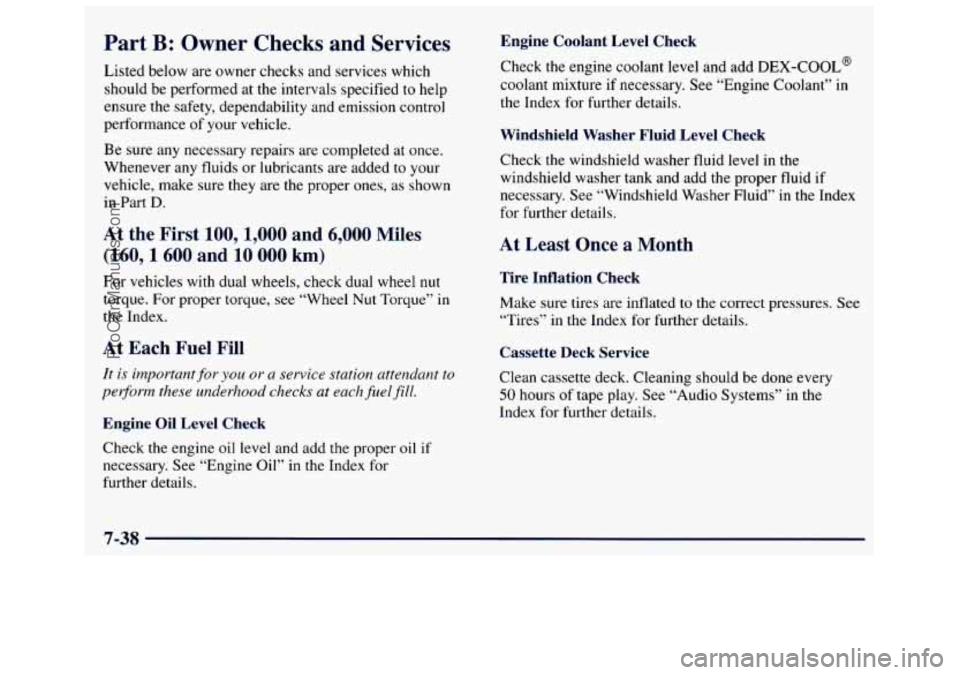
Part B: Owner Checks and Services
Listed below are owner checks and services which
should be performed at
the intervals specified to help
ensure the safety, dependability and emission control
performance
of your vehicle.
Be sure any necessary repairs are completed at once.
Whenever any fluids or lubricants are added to your
vehicle, make sure they are the proper ones, as shown
in Part
D.
At the First 100, 1,000 and 6,000 Miles
(160,1600 and 10 000 km)
For vehicles with dual wheels, check dual wheel nut
torque. For proper torque, see “Wheel Nut Torque” in
the Index.
At Each Fuel Fi”
It is important for you or a service station attendant to
per$orrn these underhood checks
at each fitelfill.
Engine Oil Level Check
Check the engine oil level and add the proper oil if
necessary. See “Engine Oil” in the Index for
further details.
Engine Coolant Level Check
Check the engine coolant level and add DEX-COOL@
coolant mixture if necessary. See “Engine Coolant” in
the Index for further details.
Windshield Washer Fluid Level Check
Check the windshield washer fluid level in the
windshield washer tank and add the proper fluid if
necessary. See “Windshield Wdsher Fluid” in the Index
for further details.
At Least Once a Month
Tire Inflation Check
Make sure tires are inflated to the correct pressures. See
“Tires” in the Index for further details.
Cassette Deck Service
Clean cassette deck. Cleaning should be done every
50 hours of tape play. See “Audio Systems” in the
Index for further details.
7-38
ProCarManuals.com